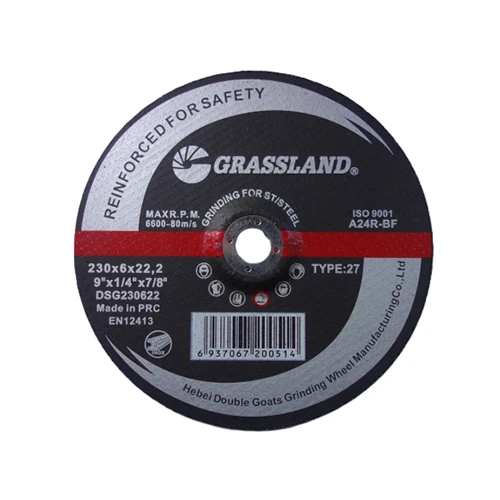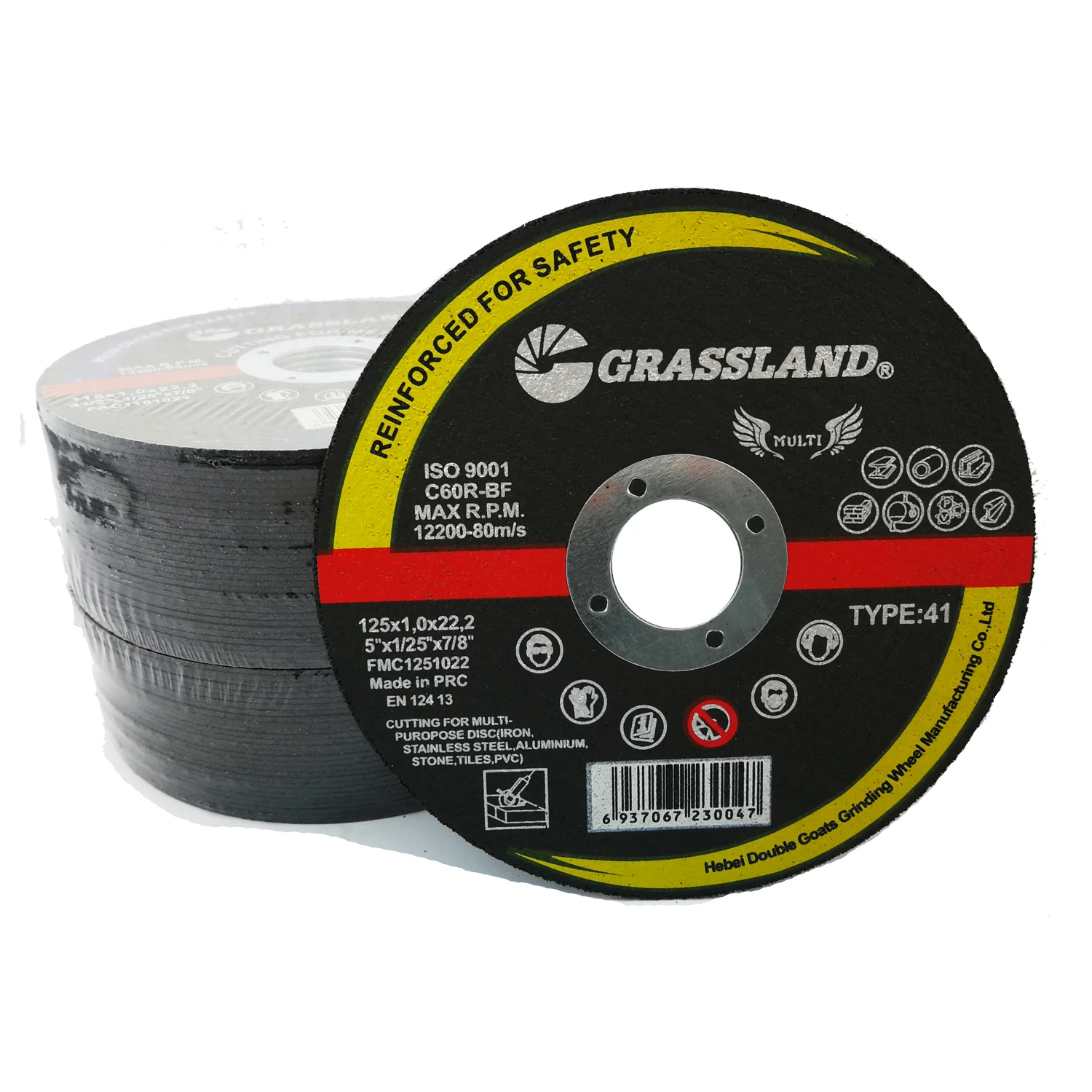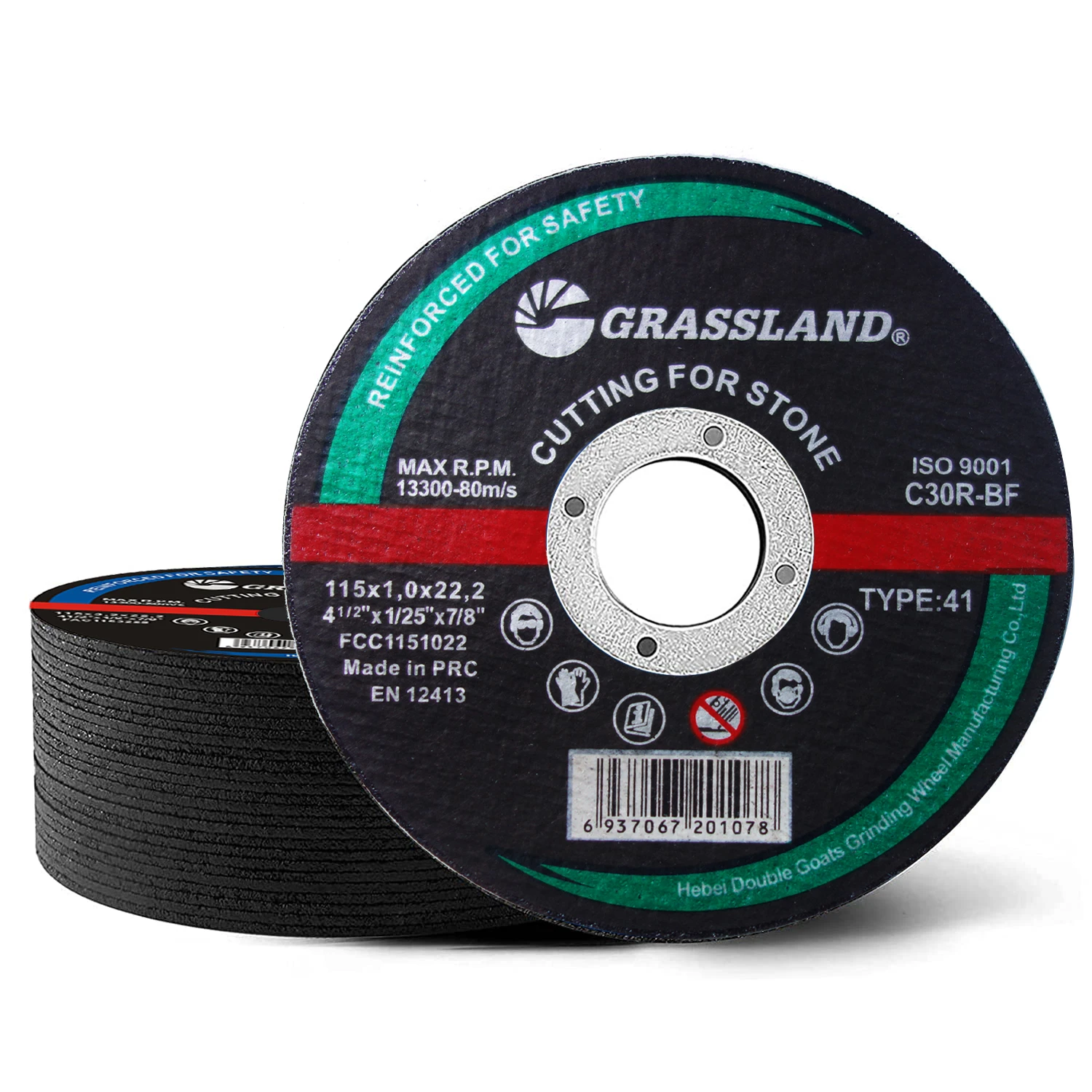Introduction to Flexible Grinding Technology in Industrial Applications
In high-precision manufacturing and metal fabrication, the choice of abrasive tools significantly impacts surface finish, material integrity, and operational efficiency. Among the diverse array of grinding solutions, the flexible grinding wheel has emerged as a cornerstone for applications demanding versatility and superior surface quality. These specialized discs offer an unparalleled ability to conform to irregular surfaces, making them indispensable for tasks ranging from intricate deburring to comprehensive weld blending and surface conditioning. Unlike rigid abrasive tools, the inherent flexibility of these wheels minimizes workpiece gouging, reduces heat buildup, and achieves a consistent finish, particularly on contoured or delicate materials. The market for flexible grinding solutions, including the ubiquitous flexible grinding disc, continues to expand as industries seek more efficient, precise, and less labor-intensive methods for material removal and surface preparation. GRASSLAND, for instance, offers high-performance options like their 4″ FLEXIBLE GRINDING DISC 100X3X16MM, engineered for demanding industrial environments.
This article delves into the technical intricacies, manufacturing processes, application spectrum, and key advantages that position flexible grinding wheels at the forefront of modern abrasive technology. We aim to provide B2B decision-makers and technical engineers with a comprehensive understanding of how these tools contribute to enhanced productivity and superior product quality across various sectors.
The Advanced Manufacturing Process of Flexible Grinding Wheels
The production of a flexible grinding wheel is a sophisticated process involving precise material selection and controlled manufacturing steps to achieve optimal performance characteristics. Understanding this process is crucial for appreciating the technical advantages of these tools.
Key Materials and Components:
- Abrasive Grains: Primarily high-quality aluminum oxide (for general purpose grinding on steels) or silicon carbide (for non-ferrous metals and harder materials). The grain size, ranging from coarse (e.g., P36) for aggressive material removal to fine (e.g., P120) for surface finishing, dictates the cutting action and final finish.
- Resin Bond System: A carefully formulated blend of thermosetting resins (e.g., phenolic resins) acts as the matrix holding the abrasive grains together. The flexibility of the final product is significantly influenced by the elasticity and curing properties of this resin system.
- Reinforcement: Multiple layers of high-tensile fiberglass mesh are incorporated to provide structural integrity, bursting strength, and operational safety, especially at high rotational speeds.
- Filler Materials: Additives that can influence the wheel's hardness, porosity, and grinding performance, such as cryolite or pyrite, which can aid in cooler grinding.
Manufacturing Process Flow:
- Material Preparation: Abrasive grains are accurately weighed and mixed with the liquid resin binder and fillers in specialized blending equipment to ensure homogeneous distribution.
- Forming (Pressing): The prepared mix is then precisely distributed onto reinforcing fiberglass layers within a mold. This assembly is subjected to high hydraulic pressure, compacting the materials into the desired disc shape and thickness. This step is critical for density and structural consistency.
- Curing (Baking): The pressed discs are transferred to large industrial ovens where they undergo a controlled curing process at specific temperatures and durations. This thermosetting reaction solidifies the resin bond, creating a strong, yet flexible, matrix. The curing profile is vital for the wheel's hardness, elasticity, and service life.
- Finishing and Balancing: After curing, the wheels are trimmed, and a metal retaining ring is often attached to the arbor hole. Each wheel undergoes a balancing procedure to ensure smooth, vibration-free operation at high RPMs.
- Testing and Quality Control: Every batch is rigorously tested for compliance with international standards such as ISO 525 (Safety Requirements for the Design and Designation of Grinding Wheels) and ANSI B7.1 (Safety Requirements for the Use, Care, and Protection of Abrasive Wheels). Tests include burst speed testing, dimensional accuracy, hardness, and performance grinding trials.
The stringent adherence to these processes ensures that the final flexible grinding disc exhibits superior performance, safety, and longevity. The service life of such wheels, when manufactured correctly and used according to specifications, typically exceeds that of standard rigid wheels in specific applications due to their self-sharpening properties and reduced glazing.
Target industries benefiting from these highly engineered tools include petrochemical (for pipeline weld cleaning), metallurgy (for surface conditioning of various alloys), and water supply & drainage (for pipe fabrication and repair). Advantages in typical application scenarios include significant energy saving due to efficient material removal and reduced operator fatigue, and enhanced corrosion resistance post-grinding due to improved surface integrity, minimizing pockets where rust can form.

Image 1: An illustrative example of a flexible grinding wheel in action.
Industry Trends and Innovations in Flexible Grinding
The abrasive industry is constantly evolving, driven by demands for increased efficiency, precision, and sustainability. For flexible grinding applications, several key trends are shaping the future:
- Advanced Abrasive Grains: Development of ceramic abrasive grains and engineered agglomerates that offer superior cutting rates, longer life, and cooler grinding compared to traditional aluminum oxide. These grains micro-fracture during use, continually exposing sharp new cutting edges.
- Eco-Friendly Binders and Manufacturing: A growing focus on reducing environmental impact by developing solvent-free or lower VOC (Volatile Organic Compound) resin systems and optimizing manufacturing processes to minimize waste and energy consumption.
- Automation and Robotics Integration: Flexible grinding wheels are increasingly being integrated into robotic grinding systems. Their conformability makes them ideal for automated deburring and finishing of complex parts, reducing manual labor and improving consistency.
- IoT and Sensor Technology: While still nascent, the integration of sensors into grinding tools or machines to monitor performance parameters like vibration, temperature, and wear is on the horizon. This data can inform predictive maintenance and optimize grinding processes.
- Specialized Formulations for Exotic Materials: As industries like aerospace and medical device manufacturing increasingly use difficult-to-machine alloys (e.g., Inconel, Titanium), there's a trend towards developing flexible grinding wheels specifically engineered for these materials to prevent heat damage and ensure optimal surface integrity.
These innovations underscore the commitment of manufacturers to deliver abrasive solutions that not only meet current industrial demands but also anticipate future challenges, particularly in enhancing safety, extending tool life, and achieving superior surface finishes more efficiently.
Technical Specifications and Performance of Flexible Grinding Discs
The performance of a flexible grinding wheel is characterized by a set of technical parameters that dictate its suitability for specific applications. Understanding these specifications is critical for selecting the right tool for the job and optimizing grinding efficiency.
Key Technical Parameters:
- Abrasive Type: Aluminum Oxide (A), Zirconia Alumina (ZA), Silicon Carbide (C). Each has distinct properties for different materials and applications.
- Grit Size: Ranges from coarse (e.g., 36, 40) for heavy stock removal and aggressive grinding to fine (e.g., 60, 80, 120) for blending, deburring, and surface finishing.
- Bond Type: Typically resinoid bonds for flexibility and shock absorption. The specific resin formulation influences the wheel's hardness and wear rate.
- Hardness Grade: Refers to the strength of the bond holding the abrasive grains. Grades range from soft (e.g., J, K) to hard (e.g., R, S). Softer wheels release dull grains more easily, exposing new sharp edges for cooler grinding, while harder wheels offer longer life on less aggressive applications.
- Dimensions: Diameter (e.g., 4", 5", 7"), Thickness (e.g., 3mm, 4.5mm, 6mm), and Arbor Hole Size (e.g., 5/8", 7/8", 22.23mm).
- Maximum Operating Speed (RPM/m/s): A critical safety parameter, indicating the maximum rotational speed the wheel can safely withstand. GRASSLAND 4″ FLEXIBLE GRINDING DISC 100X3X16MM, for instance, typically has a Max. RPM around 15,300.
Product Specification Table: GRASSLAND 4″ FLEXIBLE GRINDING DISC 100X3X16MM
| Parameter | Specification |
|---|---|
| Product Name | GRASSLAND 4″ FLEXIBLE GRINDING DISC |
| Dimensions (Dia x Thk x Bore) | 100 x 3 x 16 mm (4″ x 1/8″ x 5/8″) |
| Abrasive Type | Premium Aluminum Oxide (A) |
| Grit Size (Typical) | P40 (Coarse to Medium) |
| Bond Type | Reinforced Resinoid |
| Hardness Grade | Medium (e.g., T grade for high material removal and durability) |
| Max Operating Speed | 15,300 RPM / 80 m/s |
| Standard Compliance | EN 12413, ISO 525 |
| Application Suitability | Steel, Stainless Steel, Iron, General Metal Grinding |
Regarding flexible grinding wheel price, it often reflects the quality of abrasive grains, the sophistication of the bond system, and adherence to manufacturing standards. While potentially higher than basic rigid wheels, the total cost of ownership is often lower due to extended tool life, faster material removal, and superior finish requiring less secondary processing. Comparing "what are the types of grinding wheels," flexible options are generally positioned for tasks requiring moderate material removal with emphasis on surface quality and conformity, bridging the gap between heavy stock removal wheels and fine finishing abrasives.

Image 2: Close-up of a flexible grinding disc highlighting its construction.
Application Scenarios and Technical Advantages
The unique flexibility and controlled aggression of flexible grinding wheels make them indispensable across a multitude of industrial applications where precision and surface integrity are paramount.
Typical Application Scenarios:
- Weld Blending and Finishing: Essential for smoothing down weld beads without undercutting or excessive material removal, crucial in industries like shipbuilding, structural steel fabrication, and pipeline construction.
- Deburring and Edge Chamfering: Effectively removes burrs and sharp edges from machined or cut parts, improving safety and preparing surfaces for subsequent operations like painting or assembly.
- Surface Conditioning and Preparation: Ideal for cleaning rust, scale, paint, and other coatings, as well as creating a consistent scratch pattern for optimal adhesion in painting or coating processes. This is widely used in automotive and aerospace maintenance.
- Contour Grinding: Their ability to conform to curved or irregular surfaces makes them perfect for grinding inside pipes, on turbine blades, or complex mold tooling, where rigid wheels would be impractical or cause damage.
- Metal Fabrication: Used for general grinding, shaping, and finishing on various metals including stainless steel, carbon steel, and aluminum in workshops and manufacturing plants.
Technical Advantages:
- Superior Surface Finish: The inherent flexibility allows for smoother material removal, significantly reducing the risk of gouging and minimizing chatter marks, leading to a higher quality surface that often requires less post-processing.
- Reduced Heat Generation: The softer bond and abrasive properties of flexible grinding wheels facilitate cooler grinding action. This is crucial for heat-sensitive materials, preventing metallurgical changes, discoloration, and warping, thereby contributing to energy saving in cooling systems and reducing material waste.
- Enhanced Operator Comfort and Safety: The flexibility absorbs more vibration, reducing operator fatigue and increasing control. Lower grinding noise and less sparks contribute to a safer working environment.
- Versatility: A single flexible wheel can often perform tasks that would require multiple grades or types of rigid wheels, from moderate stock removal to fine blending. This consolidates inventory and simplifies processes.
- Improved Corrosion Resistance: By achieving a smoother, more uniform surface finish, the potential for microscopic irregularities that can trap moisture and accelerate corrosion is reduced, leading to parts with superior corrosion resistance and extended service life.
These technical advantages translate directly into significant operational benefits, including reduced cycle times, lower material wastage, and a higher quality end-product, making flexible grinding an economically sound choice for many industrial operations.
Vendor Comparison and GRASSLAND's Competitive Edge
When sourcing flexible grinding wheels, B2B buyers face a myriad of choices. Differentiating between manufacturers and their offerings is crucial for securing optimal performance, reliability, and value. Key criteria for vendor comparison typically include product quality, certifications, innovation, technical support, and pricing structures.
General Vendor Comparison Points:
- Product Portfolio & Specialization: Does the vendor offer a wide range of abrasive types and sizes, or do they specialize in certain niche areas?
- Manufacturing Standards & Certifications: Adherence to international standards (e.g., ISO 9001 for quality management, EN 12413 for safety) signifies commitment to quality and safety.
- Raw Material Quality: The source and quality of abrasive grains and resin binders significantly impact tool performance and lifespan.
- Technical Support & Expertise: The ability to provide application-specific advice, troubleshooting, and training.
- Customization Capabilities: Can the vendor tailor products to unique operational requirements?
- Pricing and Supply Chain Reliability: Competitive pricing combined with consistent product availability and efficient logistics.
GRASSLAND's Competitive Edge:
GRASSLAND differentiates itself by focusing on a blend of performance, durability, and cost-effectiveness, particularly in its flexible grinding disc offerings like the 4″ FLEXIBLE GRINDING DISC 100X3X16MM.
- Premium Abrasive Quality: Utilizing carefully selected, high-grade aluminum oxide ensures consistent aggression and superior material removal rates, translating to faster job completion.
- Optimized Bond System: Engineered resinoid bonds provide the ideal balance between flexibility for contouring and rigidity for effective cutting, minimizing glazing and maximizing wheel life.
- Safety Compliance: All products, including the GRASSLAND 4″ flexible disc, adhere to strict international safety standards such as EN 12413, guaranteeing operational safety and operator confidence.
- Value Proposition: GRASSLAND products are positioned to offer a superior performance-to-price ratio, reducing overall operational costs through extended lifespan and efficient grinding.
Product Comparison: GRASSLAND vs. Generic Flexible Disc (Typical Specifications)
| Feature | GRASSLAND 4″ Flexible Disc | Generic Brand Flexible Disc |
|---|---|---|
| Abrasive Grain | Premium Aluminum Oxide (consistent, sharp) | Standard Aluminum Oxide (variable quality) |
| Bond System | Optimized Resinoid (balanced flexibility/durability) | Basic Resinoid (less balanced) |
| Material Removal Rate | High (efficient and fast) | Moderate (slower, requires more pressure) |
| Tool Life | Extended (engineered for durability) | Standard (shorter due to faster wear) |
| Surface Finish | Superior (minimal gouging, consistent) | Good (potential for uneven finish) |
| Heat Generation | Lower (cooler grinding) | Higher (risk of workpiece damage) |
| Safety Compliance | EN 12413 Compliant | Variable, may not meet all standards |
Customized Solutions and Application Case Studies
Recognizing that industrial grinding challenges are rarely one-size-fits-all, leading manufacturers like GRASSLAND offer customized solutions for flexible grinding wheels. This bespoke approach ensures that the abrasive tool precisely matches the material, geometry, and desired finish of a specific application.
Customization Options Include:
- Specific Abrasive Blends: Combining different abrasive grains (e.g., Alumina and Zirconia) for hybrid performance on challenging alloys.
- Tailored Bond Systems: Adjusting resin formulations for enhanced flexibility, aggressiveness, or heat resistance specific to the workpiece material.
- Unique Dimensions and Shapes: Producing non-standard diameters, thicknesses, or even custom profiles for highly specialized machinery or part geometries.
- Additives: Incorporating grinding aids (e.g., active fillers) to improve cutting action on exotic materials, reduce friction, or extend wheel life.
Application Case Studies:
Case Study 1: Automotive Frame Weld Blending
A major automotive manufacturer faced challenges in efficiently blending intricate welds on high-strength steel vehicle frames. Traditional rigid grinding wheels often caused undesirable material removal and localized heat stress, leading to rework.
Solution: Working with GRASSLAND, a customized flexible grinding wheel with a finer grit (P80) and a slightly softer bond was developed. This disc provided enhanced conformability to the complex weld contours and reduced heat buildup.
Results: The implementation led to a 25% reduction in grinding time per frame, a 15% decrease in abrasive tool consumption, and a significant improvement in the aesthetic and structural integrity of the welded joints. Customer feedback highlighted "markedly superior surface finish and less operator fatigue."
Case Study 2: Marine Propeller Deburring
A shipbuilding yard needed to deburr and blend edges on large bronze marine propellers. The intricate curves and sensitive material required a tool that would not compromise the aerodynamic profile or cause pitting.
Solution: A specially formulated flexible grinding disc with a silicon carbide abrasive (C60) and a very elastic resin bond was provided. Silicon carbide is ideal for non-ferrous metals, and the bond allowed for gentle material removal without marring the surface.
Results: Deburring time was cut by 30%, and the need for manual hand-finishing was drastically reduced. The propellers achieved a smoother, more efficient hydrodynamic surface, leading to improved vessel performance and extended component life.

Image 3: A worker utilizing a flexible grinding wheel for surface preparation.
Trust and Reliability: Ensuring Your Investment
Frequently Asked Questions (FAQ) about Flexible Grinding:
Q1: What materials can a flexible grinding wheel be used on?
A1: Our flexible grinding discs are primarily designed for ferrous metals (steel, stainless steel, cast iron) and can also be effective on some non-ferrous metals like aluminum, depending on the abrasive type. GRASSLAND's aluminum oxide wheels excel on steel and stainless steel.
Q2: How does a flexible grinding wheel differ from a flap disc?
A2: While both offer flexibility, a flexible grinding wheel is a solid, resin-bonded abrasive disc, providing consistent cutting action across its entire surface. A flap disc consists of overlapping abrasive flaps, which self-expose fresh abrasive as they wear. Flexible grinding wheels typically offer more aggressive material removal with a finer finish than many flap discs, especially for blending.
Q3: What is the recommended safety practice when using these wheels?
A3: Always adhere to grinder manufacturer guidelines and relevant safety standards (e.g., ANSI B7.1, EN 12413). Wear appropriate PPE including eye protection, gloves, and hearing protection. Ensure the wheel's maximum RPM rating is not exceeded by the grinder. Use proper mounting techniques.
Q4: Can these wheels be used for cutting?
A4: No, flexible grinding wheels are designed for grinding, blending, and deburring, not for cutting. Cutting operations require thinner cut-off wheels specifically designed for lateral forces.
Lead Time & Fulfillment Details:
GRASSLAND maintains robust inventory levels for standard flexible grinding wheel products like the 4″ FLEXIBLE GRINDING DISC 100X3X16MM, ensuring prompt dispatch typically within 2-3 business days for in-stock items. For larger orders or customized solutions, lead times will be provided upon inquiry, taking into account specific manufacturing and testing requirements. We leverage a global logistics network to ensure timely and efficient delivery to our B2B partners worldwide.
Warranty Commitments:
All GRASSLAND flexible grinding discs are manufactured under stringent quality control protocols and are backed by a standard manufacturer's warranty against defects in materials and workmanship. This commitment reflects our confidence in the durability and performance of our products. Specific warranty terms and conditions are available upon request and are designed to provide our customers with peace of mind regarding their investment.
Customer Support and Technical Assistance:
Our dedicated team of technical experts and customer service representatives is available to provide unparalleled support. From product selection and application optimization to troubleshooting and customized solution development, GRASSLAND is committed to being a reliable partner. We offer technical consultations, performance data analysis, and product training to ensure our clients maximize the potential of their abrasive tools. Reach out via our website, email, or direct phone lines for expert assistance.
Conclusion
The flexible grinding wheel stands as a testament to advanced abrasive technology, offering a unique blend of material removal capability, exceptional surface finish, and operational versatility. Its ability to conform to complex geometries while reducing heat generation and operator fatigue makes it an indispensable tool for modern industrial applications across metallurgy, automotive, aerospace, and general fabrication. Manufacturers like GRASSLAND, through their commitment to quality, adherence to international standards, and continuous innovation, ensure that professionals have access to high-performance solutions that drive efficiency and elevate product quality. Investing in the right flexible grinding disc means investing in precision, safety, and long-term operational excellence.
References
- International Organization for Standardization (ISO). ISO 525:2019, Abrasive products — General requirements for the design and designation of grinding wheels.
- American National Standards Institute (ANSI). ANSI B7.1-2023, Safety Requirements for the Use, Care, and Protection of Abrasive Wheels.
- European Committee for Standardization (CEN). EN 12413:2020, Safety requirements for bonded abrasive products.
- Manufacturers' Abrasive Corporation. "Abrasive Technology Handbook." 2018.
- Modern Machine Shop. "The Evolution of Grinding Wheels." October 2021.
Post time:Aug - 31 - 2025

















